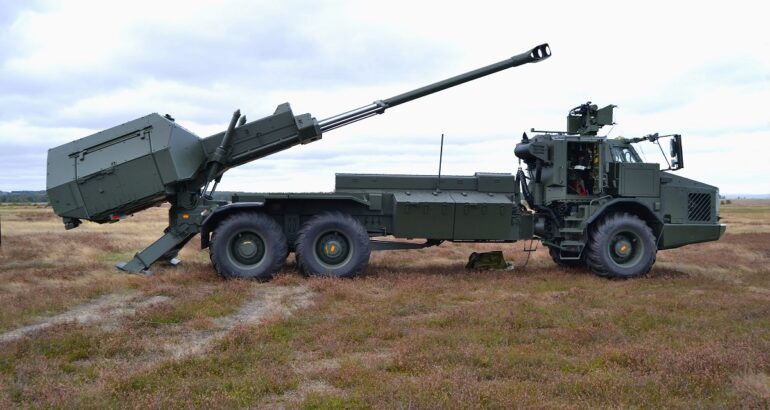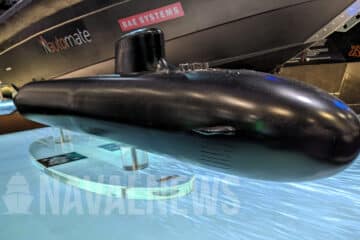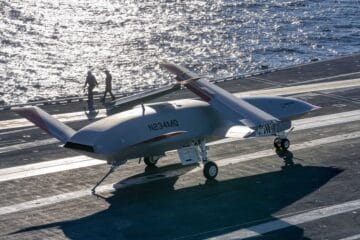SPHs, and wheeled mobile howitzers, having a high rate-of-fire, fully automatic ammunition loading; automatic traverse, elevation, and firing; and short emplacement and displacement times, 155mm mobile howitzers have finally advanced to the point of achieving a good hit percentage against a moving target, large or small. Thus, land armies are giving renewed attention to these fast moving wheeled 155mm mobile artillery systems that could also transition interest towards the Marines.
Most land armies envision using Long-Range Precision Fires (LRPF) missiles and Land Based Anti-Ship Missiles (LBASM) to attack surface warships out from a few dozen to a few hundred miles since LRPFs and LBASMs have the best chance of ensuring a hit, and the missiles’ long range can deter enemy warship encroachment. Very large Tactical Ballistic Anti-Ship missiles, especially those on Chinese and Russian Transporter Erector Launcher (TEL) trucks, can range out to over 1,000 miles (1,609 km) and provide effective deterrence over-the-horizon, keeping naval forces at a distance. Due to the limited number of mounted missiles per truck launcher, deterrence by a few coastal LBASMs can keep some enemy warships at a distance; however, the lack of quantities of LBASM trucks and their reloading support trucks means that LBASM trucks might be hard-pressed to stop a determined large-sized amphibious invasion force once all the missiles are expended.
Thus, 155mm SPHs or wheeled mobile howitzers acting as coastal artillery batteries start to appeal to land armies because a single 155mm mobile howitzer can carry around 20 to 40 155mm precision-guided munitions compared to a Multiple Launch Rocket System (MLRS) truck firing anywhere from two to twelve or more guided precision LBASMs. Quantity of ammunition has a quality deterrence all its own.
The 155mm Hypervelocity Howitzer Round is a “Game Changer”

Advances in 155mm howitzer fire control technology, Hypersonic glide flight bodies, precision GPS guidance, and enhanced rocket motors have created high-technology tube artillery ordnance that provide new capabilities to mobile artillery cannons.
On September 3rd, 2020, a Hypervelocity Projectile (HVP) fired from an U.S. Army 155mm M109A6 “Paladin” tracked SPH successfully intercepted a BQM-167 target drone simulating a cruise missile. This is “Game Changing” significant because M109s are more available and common in the field than dedicated and specialized LBASM trucks, and a HVP artillery shell’s glide body, often used for supporting ground fire, hit a small moving aerial target. Thus, a 155mm SPH firing precision-guided HVP rounds can engage and destroy incoming cruise and tactical ballistic missiles ordinary reserved for specialized, expensive, and rare Air Defense missile assets.
In this drone-intercept test, the 155mm HVP used can fire out to 58 miles (93 km or 50 nautical miles) and the HVP munition weighs in at 68 lb (31 kg) with a 46 lb (21 kg) flight body containing a warhead and guidance.
Thus, with the HVP round, not only can 155mm tube artillery engage land and sea targets, they can also intercept certain missile and aerial targets as well when teamed with remotely-located sensors such as unmanned aerial drones, Airborne Warning and Command System (AWACS) planes, and ground or ship radars that can detect enemy warships over the horizon, and send firing coordinates via secure network data-linking for Integrated Warfare (IW) operations in the U.S. Army’s “Multi-Domain Operations” (MDO) and the U.S. Navy’s “Distributed Lethality” battlefield concepts. This networking creates a “Force Multiplier Kill Chain” and the new precision-guided munitions could produce new multi-mission firepower assets for the Army and Marines to keep littoral threats at bay than just providing artillery ground fire support to advancing ground units. A new kind of “Shooter” is born.
Although the U.S. Marines, and many other NATO Marine Corps have divested of their tracked self-propelled howitzers years to decades ago, preferring lighter helicopter sling-loaded towed 155mm howitzers instead, the new 155mm HVP and precision-guided extended range munitions, such as Excalibur and Vulcano, could bring renewed investing in 155mm mobile howitzers.
U.S. Army Issues a RFP for a 155mm Mobile Wheeled Gun System
In July 2020, the United States Army has issued a Request for Proposals (RFP) for a 155mm Wheeled Gun System (WGS) as a faster, lighter, and more mobile alternative than the heavier M109A6 “Paladin” tracked Self-Propelled Howitzer. Naval News will examine two 155mm WGS systems and how and why they might qualify towards Anti-Ship artillery for the United States and NATO. All NATO-standard 155mm ammunition should be able to be transported and fired by these WGSs, such as High Explosive, High Explosive Extended Range, Illumination, and Smoke, in addition to specialized precision-guided projectiles and Hypervelocity Projectiles (HVP).
AM General’s® 155mm 6×6 “Brutus”

AM General returned a call and an email by Naval News, stating the following:
Currently, our Brutus 155mm Mobile Howitzer is in the testing phase, and has not been contracted by the U.S. Government. We have had interest from the U.S. Marine Corp and our solution can certainly be adapted to fit a 6×6 MTVR.
AM General spokesperson
AM General’s 155mm “Brutus” mounts a simplified M776155mm howitzer (without wheels and towing arms) on the flatbed of a 6×6 U.S. Army FMTV or U.S.M.C. MTVR truck, with or without armored cab. The “Brutus” was designed to keep up with the U.S. Army’s Stryker Brigade Combat Teams (SCBTs). Towing a M777 adds drag to the FMTV, slowing it behind the fast 8×8 Strykers, but carrying the M777 on the cargo bed allows the “Brutus” to keep up with the Strykers (or U.S. Marine Corps 8×8 amphibious Armored Combat Vehicles if mounted on MTVRs) for land maneuver warfare. The “Brutus” essentially reuses the FMTVs that previously towed the M777s for the U.S. Army’s SCBTs.
The 155mm “Brutus” M776uses a hydraulic hybrid soft-recoil mechanism that takes 60-65% of the recoil out of the firing process and doesn’t place the recoil stress onto the FMTV. Essentially, the “forward-recoiling” hybrid soft-recoil mechanism moves the barrel and breach forward first when the gun is fired, and effectively cancels out much of the recoil going backwards, making the howitzer more accurate and able to be fired when mounted on medium tactical trucks. The 155mm “Brutus” howitzer has no armored turret, leaving the firing crew exposed to the weather, enemy fire, and counter-battery fire although an advantage to this design is that the M776 can be dismounted via screws, removed, and remounted and transported via another FMTV if the host FMTV 6×6 truck is somehow disabled.
The experimental M776 “Brutus” prototype weighs in at 14.81-tons (29,620 lb), including the unarmored FMTV 6×6 truck, or under half the weight of the 33-ton BAE Systems 155mm ARCHER system (66,000 lb). As of late October, 2020, AM General’s spokesperson reported that there is no sling-load data; however, in theory, a “Brutus” could be slung under the new U.S.M.C. CH-53K helicopter with a maximum sling-load rating of 18-tons. The “Brutus” requires a crew of 5-7 people (5 minimum) and fires at a rate of five rounds per minute maximum and two rounds per minute sustained. Maximum range with Charge 5 is 15.5 miles (24.7 km), and Rocket-Assisted Projectile(RAP) is 18.75 miles (30 km).AM General declined to comment on if the “Brutus” has fired the Excalibur or Vulcano precision-guided GPS extended-range round, citing that the M776 can fire any round deemed fit for 155mm cannons.155mm ammunition for the “Brutus” has to be provided from a separate accompanying truck.

What makes the “155mm Brutus” appealing is that the M776 howitzer could be mounted on existing U.S. Army FMTV and U.S. Marine Corps MTVR vehicles already in service with some modifications and have the ammunition carried by a separate6x6 truck to increase survivability. This, in theory, makes the “Brutus” a cheaper and lighter WGS alternative that can be brought in larger numbers compared to some of the more advanced and complex WGSs that have to be custom built and maintained, such as BAE System’s 155mm ARCHER.
BAE System’s 155mm ARCHER

BAE Systems has proposed its ARCHER howitzer in response to the U.S. Army’s request for proposals [RFP] for a 155 mm wheeled gun system. ARCHER is a fully automated weapon system that provides highly responsive and versatile fire support to troops in combat. BAE Systems is offering ARCHER for participation in the [U.S.] Army’s plans to conduct a `shoot off’ evaluation early next year at the Yuma Proving Ground in Arizona. The Army’s RFP, released on July 30, looks to evaluate mobile howitzers in support of future Army requirements. ARCHER is already in service with the Swedish Army with the highest technical and manufacturing readiness levels
BAE Systems press release YR2020
The 33-ton (66,000 lb) BAE System’s ARCHER, designed in 1995,mounts thead mired Bofors FH 77 155mm/52-caliber cannon at the rear of a 6×6 Volvo A30D all-terrain articulated hauler. A30D truck speeds are 40 mi/h (65 km/h) with a range of 310 miles (500 km). ARCHER can also mount on a German Rheinmetall MAN RMVV HX2 8×8 truck that has speeds of 55 mi/h (90 km/h) and a range of 403 miles (650 km). The truck’s configuration separates the 155mm ammunition from the armored crew cab for increased survivability and ARCHER can be transported via rail, sea, and air.

The 155mm/L52 cannon can fire up to 24.8 miles (40 km)with conventional extended rangehigh explosive shells, and up to 31 miles (50 km)using Excalibur GPS-guided rounds. Firing HVP rounds through the 155mm/L52 gun howitzer can theoretically extend that range out to 58 miles (93 km). Leonardo’s Vulcano precision-guided munition rounds have a advertised M777 range of 37.2 miles (60 km) to over 62.1 miles (100+ km) when using the M109A7’s Extended Range Cannon Artillery (ERCA) tube. ARCHER can also fire the 155mm BONUS specialized Anti-Armor round with two Explosively Formed Penetrator (EFP) submunitions against armored targets out to 21.7 miles (35 km). The system also includes the separate ammunition support carrier truck, a removable container with 100 rounds mounted on an armored truck that can reload the MAN 8×8 ARCHER in five minutes. Total unit cost is around $4.5 million.
ARCHER promotes itself as being able to fire the first round in less than 30 seconds of emplacement and being able to stow the cannon and depart in less than 30 seconds for the Volvo chassis. The BAE Systems brochure states that the German Rheinmetall RMVV MAN HX2 8×8 ARCHER can go in and out of action in 20 seconds. Onboard ballistics calculation, automatic electronic fuse setting, digitized fire missions, radio and data communications, cannon traverse and elevation, and automatic ammunition handling is handled from within the armored cab and no crewmember mans the 155mm cannon turret.
The ARCHER mobile howitzer comes with an armored and ballistic windows cab offering protection against Nuclear, Biological, and Chemical warfare, 7.62mm armor piercing rounds, artillery shrapnel, fragmentation, and mines up to 6 kg (13.2 lb).The Volvo A30D and German RMVV MAN 8×8 can drive with all the tires punctured by mines or small arms to increase survivability in case of emergencies.
The 155mm cannon turret contains 21 stored rounds. Burst rate-of-fire is three rounds in twenty seconds, 8-9 rounds sustained per minute, or all 21 rounds fired in 3.5 minutes using automatic ammunition handling. ARCHER can lay a six-round Multiple Round Simultaneous Impact on target from different incoming angle trajectories. These impressive Bofors FH 77 155mm/L52-caliber specifications make the ARCHER attractive as amobile wheeled howitzer for coastal artillery defense against close-in littoral combat warships, and can carry andfire more ammunition than LBASM trucks.
An accompanying ammunition carrier can reload all 21 rounds in 5 minutes for the RMVV MAN 8×8 truck to 10 minutes for the 6×6 Volvo A30D truck using a purpose-built lifting device.
The ballistic armored cab seats four, normally a gun/vehicle commander, one or two cannon operator(s), and a driver although the entire howitzer firing process just requires a driver and a single gun operator.The crew never has to leave the cab to fire the cannon. An optional .50cal heavy machine gun or 40mm grenade launcher Remote Weapons Station such as the PROTECTOR or CROWS II can mount over the cab for surveillance and defense against close-in threats in all weather, day and night.
Currently, 48 ARCHERs serve with the Swedish Army with canceled orders from Norway and Croatia due to scheduling for the former and financial reasons for Croatia.
The ARCHER’s entry into the U.S. Army’s WGS RFP could have effects that might mitigate to the Anti-Ship and coastal artillery defense roles, and even interest by the Marine Corps of the U.S. and NATO nations. If implemented as Anti-Ship artillery, a group of ARCHERs could fire over the horizon using remote sensors such as ground-based, ship, or aerial radars and Unmanned Aerial Systems.
A call and email to BAE Systems seeking more information was not immediately answered.
155mm Wheeled Gun Systems Would Be Useful for Navy and Marine Littoral Warfare

The U.S. Army’s interest in a wheeled mobile howitzer could pave the way for the U.S. Marines and NATO to implement 155mm Wheeled Gun Systems for coastal, port, waterway, Arctic, littoral, and Anti-Access/Area Denial island defense. A mobile 6×6 or 8×8 155mm cannon, having a magazine of around 20-40 rounds, and able to deal with certain amphibious, armor, warship, and aerial targets using extended-range precision-guided smart projectiles would certainly have “Force Multiplication” factors for littoral defense whereas a LBASM truck carrying two to a dozen or so expensive and rare Anti-Ship missiles can reach further out to extend the coastal defense envelop.
The 155mm American “Brutus” and Swedish ARCHER Wheeled Gun System options by far do not encompass all the mobile wheeled howitzers available. Other 155mm mobile howitzers that might be invited to and qualify for the 2021 U.S. Army’s Yuma Proving Ground “Shoot Off” evaluation could be the French 6×6 or 8×8 CAESAR, the Japanese 8X8 Mitsubishi Type 19 prototype, the South African 6×6 G6 Rhino, the Israeli 6×6 Tatra T815 ATMOS, and the Slovakia (former Czechoslovakia) 8×8 DANA.
Wheeled mobile howitzers could add to the U.S. Army’s Multi-Domain Operations (MDO) tactics, and for the U.S. Marines, could contribute to the U.S. Navy’s “Distributed Lethality” for “Distributed Maritime Operations” (DMO) tactics of employing more “Shooter options” for the targeting data received via remote sensors and downloading datalinks in an effort to contribute to the Joint Force’s Integrated Warfare initiatives. The ability to rapidly set up and fire the first 155mm rounds in under half a minute, and then displace also in under half a minute, and empty more than a dozen precision-guided shells in a few minutes, means that mobile coastal artillery will give invading amphibious forces and littoral warships something else to worry about that just LBASMs and LRPF-modified land attack Anti-Ship missile trucks.






